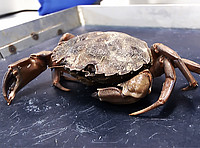The contributions include the personal and individual opinions of students and supervisors. They do not necessarily reflect the opinion of the University of Hohenheim.
“The possibility to get such exact knowledge about animal anatomy and evolutionary links is not a matter of course.”

1. The course itself:
I think that Biology students really benefit from dissection. Models and drawings are always shown in a simplified way. Dissection gives you the chance to correctly understand the links between various organs in living beings for yourself.
With the dissections done here, you’re pretty much forced to look very closely. This is, simply put, the way to learn the most.
2. Origin of the animals:
Of all the animals that were dissected, there was only one that could lead to objections for animal protection reasons: The frog, since amphibians are almost completely threatened*. Of these, however, only eight females were killed and dissected for us.
All the other animals were either breeding animals for feed (e.g. the roaches, the earthworms), from the food industry (trout, mussels), old animals from the university programs (mouse), or, tragically, industrial waste (chicks).
In other words: None of the animals that were dissected in pairs were “only” killed for dissection or were threatened species. I therefore do not have any serious reservations because of the knowledge we were able to gain with the dissections and the relatively good origin of the animals.
5. Degree programs:
I also think it’s good that only the Biology B.Sc. and the Biology Teacher Program for Secondary Schools dissect animals. That reduces the number of killed animals to those who benefit the most from it.
4. Conclusion:
The possibility to get such exact knowledge about animal anatomy and evolutionary links is not a matter of course. Dissection in its current form is therefore absolutely justified, in my opinion.
It is important, however, that we dissect with the necessary attention. An upcoming biologist should try to learn as much as possible when dissecting out of respect for the animal’s life. Only then it is ensured that the animal didn’t die “for nothing.”
Freddy, 1st semester, Biology
*Editor’s note: In contrast to many other amphibians, the clawed frog Xenopus laevis is placed in the lowest danger category (“least concern”) (not threatened) on the current IUCN Red List of threatened species. In actuality, in many countries across the world the clawed frog appears as a neozoon (an animal that - with or without human action - has established itself in an area to which it is not native).
